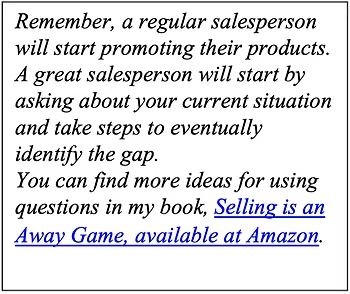In the last post, we explored the potential of enhancing your evaluation process by asking sales questions. In this post, we’ll take a deeper dive into using the questioning process to build increased interest in your prospects.
Previously, we used a river as an analogy to develop a questioning model. In this river analogy, one bank represented the prospect’s current situation. The opposite bank represented the desired situation. And the river represented the gap that the prospect must bridge in moving from the current situation to the desired situation.
Use Sales Questions to Identify Where Your Prospect Lives Right Now
The questions a salesperson asks need to reveal the prospect’s current reality. They’re the “what” questions. They could be anything about the prospect’s current situation, or what has happened that brought them to this situation. They’re sales questions like: “Tell me about your company. Tell me about your role. Tell me about what brought you into the store today.”
Let’s look at an example. Let’s say you are going to your favorite business tech store to buy a new router. You currently have a router that performed flawlessly when you purchased it for your business 3 years ago. But as you know, things change. Technology changes. Your environment expands. Your business grows.

Away Game Selling Book Quote
So now, you find your router is having trouble handling your current day-to-day traffic. In addition, you want to add a few more employees, but you know that’s going to increase your internet traffic and exacerbate the problem. And to add insult to injury, your current employees are already blaming the “slow internet” as for why they can’t get things done.
Now when you go out looking for routers, you may not know all of the technical options available to you. There’s technology out there that that can shape and prioritize traffic, perform compression, and increase overall efficiency and usage effectiveness. A good salesperson could figure that out and could help you realize that there’s potential for a better solution. They will help you bridge your current situation to where you want to be by asking the right sales questions.
Good Sales Questions Diagnose the Current Situation
So, in diagnosing the prospect’s current reality, some questions the salesperson might ask are:
- So, tell me about your current technology.
- If you had to choose, what are the top 3 features you like about your router?
- What are 2 shortcomings that you don’t like about your router?
- If you had to change something about your current technology, what would you change?
- What about your business environment?
- How many users do you have?
- What times do they start working?
- What kind of activity do they perform online?”
As you can see, there are a variety of sales questions here. Some are open-ended while others are closed. Some allow the prospect to answer in a long, essay-type format while others provide for a multiple choice. The types of sales questions you have in your arsenal are important and we’ll deal with those in another post. What’s important here is the fact that the salesperson uses their sales questions to build credibility, build trust, and build out the prospect’s current situation.
Good Sales Questions Highlight Where the Prospect Wants to Be
Let’s say that you want higher download speeds. Then, the salesperson would probably ask questions around identifying and achieving your desired outcome. For example:
- What are your growth plans for the next two years?
- What will your business focus be in that timeframe?
- How many employees do you plan on having in the near future?
- What activities do you envision your people doing to build your book of business?
- Do you plan on supporting your own technology inhouse or do you want to keep your people focused on your core business?
- What if there are other options that will allow you to bring more people online? Would that be a viable option for you?”
Again, you can see a variety in the forms of the sales questions. But the salesperson uses these questions to build credibility and trust to get the prospect to open up about their future goals, where they want to be. Your job, in your questioning process, is to create as clear a picture as possible of their future, desired situation that will give them what they really want.
Remember, no one buys a quarter-inch drill bit because they want a quarter-inch drill bit. They buy a quarter-inch drill bit because they want a quarter-inch hole. Your questions should identify what having the hole will give them.
Who Is the Questioning Process For?
Now here’s something to keep in mind. When we survey salespeople in our sessions and consultations, we ask this question: “Who is the questioning process for, the seller or the prospect?”
Most of the time, salespeople will say, “The questions are for me, the seller.”
Here’s the shocker – they’re not. They’re actually for the prospect. The prospect should be central to your questioning process.
Remember, sales is an away game. It takes place in the mind of the prospect. And that’s where your questioning process has to take you – into the mind of your prospect.
We’ll come back to that in a bit. But first, let’s review our model again through another example.
Acknowledging the Gap in the Questioning Process
Let’s have a look at another example. If I were selling financial services, I might start by asking for their current situation. “Tell me a little bit about what your philosophy is on how you put money away for your future. What does your nest egg look like? Is it good, bad, or ugly? What’s your philosophy? What’s your current 401(k) look like?”
Then, I’ll bridge to the desired situation, a desirable future. “Let’s look a little bit in the future. You’re thinking about retirement. What should it be? What are you looking to do? When are you looking to retire?”
I’m going to ask these questions where I increase the awareness of these gaps between the current and desired situations. I’m going to start by asking for more current situation questions, and then move to asking for the desired situation.
That space between their current situation and their desirable situation is the gap that we have to sell to. The greater the gap, the bigger the opportunity. But be forewarned. There’s a reason that the gap exists. You have to bring awareness of the gap and the obstacles that exist in that gap to your client. If there were no obstacles standing in your prospect’s way, then moving from their current situation to the desired situation would be easy and they would have achieved their desired situation already.
Bridging the Gap
So you need to use your questioning process not only to identify your prospect’s current situation and desired situation, but it also has to make your prospect aware of the gap and the obstacles that live there. Just as you examined their current situation and the desired situation, your questioning process has to bring those obstacles out of the cloudy murk in the gap and into full daylight where they can be examined, challenged, and resolved.
Going back to our financial services example, I’ll ask the prospect about some things that are standing in their way. They might say, “I’ve got to meet my bills now, I can’t put 10 percent away.”
And that gives me the opportunity for more probing questions, getting them to further clarify the obstacle or to challenge it. “Well, what’s going to ultimately happen if you don’t start doing it now?”
They might say, “I’m going to be in a scenario where I’m not where I need to be. I’m going to be racing towards the end and I might run out of time if I don’t start doing it now.”
At the end, I might say, “If I’m hearing it right, you’d be comfortable if you had a plan to ramp up how to get toward retirement. So, you’d be open to that?”
Building the Relationship Through Interaction
This questioning process is our ability to interact with the prospect. In some complex sales processes, this could be a whole meeting. This could also be several meetings or more as the prospect adds decision makers, because complex B2B processes currently have anywhere from three to four influencers, sideliners, a champion, and then, ultimately, a buyer. We might be performing this evaluation over a few engagements, or it might be during the very first connection.
In review, your questioning process needs to generate interest on your prospect’s behalf by highlighting the challenges they face. As the salesperson, you do this through your questions that:
- review their current situation
- highlight their desired situation
- and bring awareness to the obstacles in the gap between the two
Your questioning process also performs the critical function of building trust, framing issues, and shaping the mindset of the prospect. We’ll review that in the next post.
You’ll find more sales strategies for executing your sales process in Lance Tyson’s book, Selling Is An Away Game: Close Business and Compete in a Complex World available on Amazon. Get your copy today!




